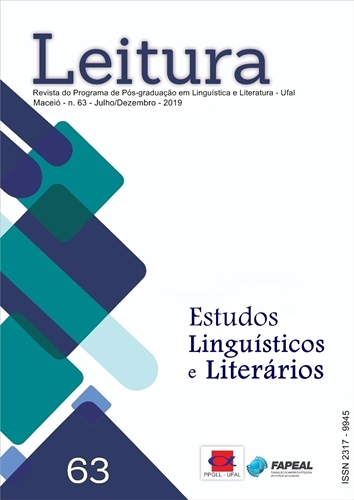O uso de fotografias em verbetes de dicionários infantis
DOI:
https://doi.org/10.28998/2317-9945.201963.138-153Parole chiave:
metalexicografia. dicionário infantil. Multimodalidade. gramática visual. fotografiaAbstract
O gênero verbete é um gênero textual pouco estudado durante a formação escolar de um indivíduo, porém sua importância é significativa para a aquisição de uma língua, materna ou não. Quando se trata desse gênero em obras lexicográficas infantis, principalmente, percebe-se a importância do texto visual, posto adequadamente, para o aprendizado da criança. Refletindo sobre essas questões, propomos, neste trabalho, trazer a análise de um dicionário infantil consagrado no mercado editorial: Aurelinho. Dicionário Infantil ilustrado da língua portuguesa (FERREIRA, 2008), para estudar os verbetes que fazem uso de texto verbo-visual apoiando-se na linguagem fotográfica, presentes nessa obra, à luz da multimodalidade e da metalexicografia. Analisamos os recursos fotográficos dos verbetes ilustrados tendo como base a Teoria da Gramática do Design Visual (GDV), pensada por Kress e Van Leeuwen (1996, 2006), e observamos a organização dos verbetes dos dicionários infantis, tendo como referência preceitos da metalexicografia, através de estudos de teóricos como Welker (2008), Pontes (2009), dentre outros. Tivemos como direcionamento o alcance desses objetivos: 1. Descrever como se dá a presença da fotografia em um dicionário infantil; e 2. Analisar como as fotografias são utilizadas nas obras lexicográficas para contribuir com a aprendizagem vocabular da criança. Neste trabalho, em decorrência, principalmente, da pouca atenção disponibilizada ao usuário dos dicionários escolares, valorizamos o consulente como elemento essencial para a ideia de organização de um dicionário, e é essa valorização uma das motivações desta pesquisa.
Using photographs in entries of dictionaries for children
Entry is a textual genre little studied during the education of an individual, but it plays an important role in the process of language acquisition, whether a mother tongue or not. When this genre is used in lexicographic works for children, more than in other contexts, we can observe the importance of visual text, if it is correctly employed, for the child's learning. With these reflections in mind, we propose, in this work, to perform an analysis of a children's book well-established in the publishing market: Aurelinho. Dicionário infantil ilustrado da língua portuguesa (FERREIRA, 2008), to study, in the light of multimodality and metalexicography, the entries of this work in which verbal-visual texts, e.g. photographs, are employed. We analyzed the photographic resources of the illustrated entries based on the Grammar Theory of Visual Design (GDV), by Kress & Van Leeuwen (1996, 2006); and we observed the organization of the entries in the children's dictionaries based on the concepts of metalexicography theorists, such as Welker (2008), Pontes (2009), and others. Our aims were: 1. Describe the role of a photograph in a dictionary for children; 2. Analyze how the photographs are used in lexicographic works in order to contribute to the child's vocabulary learning. In this work we chose to consider the school dictionary consultant, often neglected in other approaches, as a central figure in the organization of a dictionary; and this understanding is what drives the present research.
Keywords: Metalexicography. Children's dictionary. Multimodality. Visual grammar. Photography










